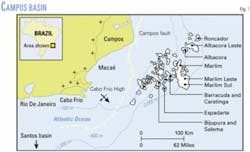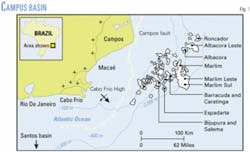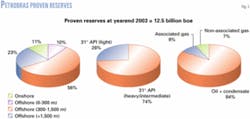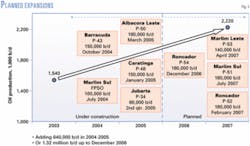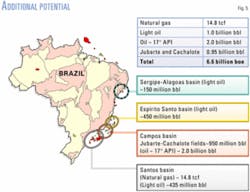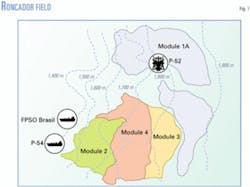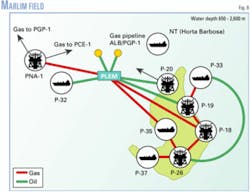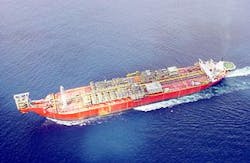Deepwater production off Brazil continues steady increase
Oil and gas production from new fields and facilities in the deepwater off Brazil continues to increase.
Petroleo Brasileiro SA (Petrobras) remains the main producer from Brazil's deepwater, although Shell Brasil Ltda. in July 2003 became the only other deepwater operator when it began oil production from Bijupirá and Salema fields in the Campos basin (Fig.1).
Petrobras operates the other producing deepwater fields in the Campos basin. Its main deepwater fields include Albacora, Albacora Leste, Barracuda, Caratinga, Espadarte, Roncador, Marlim, Marlim Leste, and Marlim Sul. Petrobras continues to add new wells and facilities to many of these giant deepwater fields (Fig. 2).
The company also has expanded production to deepwater in other basins. For instance, in the Espírito Santo basin, north of the Campos basin, Petrobras has started a pilot production operation in Jubarte field and has announced plans to develop Cachalote and Golfinho fields. Petrobras also plans to develop the deepwater Mexihão gas field in the Santos basin, which lies south of the Campos basin.
Petrobras in its 2004-15 strategic plan estimates that its proven reserves were 12.5 billion boe at the end of 2003. Of these reserves 56% were in 300-1,500 m water and 23% were in water deeper than 1,500 m (Fig. 2). Oil and condensate represent 84% of these reserves, and 74% of the liquid reserves are intermediate or heavy with a API gravity less than 31°.
Petrobras expects additionally planned developments (Fig. 3) to increase its domestic oil production to 2.22 million b/d in 2007 from the 1.54 million b/d in 2003. The company's planned developments outside of the Campos basin hold an estimated 6.6 billion boe (Fig. 4).
null
Technological challenges
Petrobras uses a phased development scheme for many of its giant deepwater fields. And to date, it has developed these fields exclusively with subsea completed wells and floating production facilities and considers such technology relatively proved.
But as Guil- merme Estrella, exploration and production director for Petrobras, told OGJ, "we are considering the possibility of installing dry-tree completions with tension-leg platforms (TLPs) or spars but Petrobras has the most experience with subsea completions and we are more comfortable with wet-tree systems. But I am encouraging our engineers to start using dry tree concepts such as TLPs to gain experience, although currently there are no plans to use a TLP."
He said that although Petrobras has met the technical challenges of floating production systems, the main remaining challenges concern well completions that include a horizontal laterals with more than a 2-km length producing at rates greater than 30,000 bo/d.
With these production rates, it takes only three to four wells to reach the capacity of a 100,000-bo/d processing vessel. He indicated that one Petrobras well has obtained 40,000 bo/d production rates and to sustain these high rates will require improved gravel-packing technology.
Estrella also sees multiphase pumping as another frontier "that will have a great benefit on how future fields will be developed." He added that Petrobras does not consider the technology reliable enough to place offshore yet, but is continuing to test the technology onshore.
Subsea separation is another technology that Petrobras is investigating, but Estrella said "multiphase pumps will be the key."
He also said that Petrobras considers intelligent wells as being no longer in the test stage. Depending on the intelligent level, he estimated that Petrobras already has two to three intelligent wells in operation and more such wells are in the plans.
Estrella also indicated that another technology challenge in the Campos basin is the production of the 2 billion bbl of heavy 14-23° gravity crude. Although the crude has low viscosity and flows easily, paraffin deposition could be a main problem, according to Estrella.
Albacora
The Albacora field covers a 455-sq km area in the northern part of the Campos basin. The field is about 110 km off the coast and lies in 230-950 m water depths. Its production peaked in December 1998 at about 174,000 boe/day.
Albacora was the first of the deepwater giant fields to go on production. The field began producing from the Namorado reservoir in October 1987 with well 1-RJS-297. Phase 1 of the project consisted of five additional wells tied to a manifold and producing to the P.P. Moraes processing vessel. Petrobras says that during this phase it collected production and reservoir data to assist in further exploitation of the field.
Development of Phase 1A started in 1989. In this phase, the company installed a second manifold to connect six additional wells, five of which produced from the Marlim sand and one from the Namorado sand.
The phase concluded in 1993 when the P-24 semisubmersible production unit replaced the P.P. Moraes and Petrobras tied in two additional producing wells, one producing from the Marlim and the other from the Namorado reservoirs.
The next development phase, Phase 2A, included further development of the Marlim sand with three wells. These started producing in September 1996. By yearend 1997, the field had 25 wells.
Phase 2B included installation of the P-31 floating production, storage offloading (FPSO) vessel connected to 35 wells (6 injectors and 29 producers) and the P-25 semisubmersible connected to 28 other producer wells.
Petrobras transferred the producing wells initially connected to P-24 to the P-31 and released the P-24 from the field at yearend 2000. This left only the P-25 semisubmersible and the P-31 FPSO in the field (Fig. 6).
The field reached peak production of 174,000 boe/d in December 1998, but Petrobras has continued additional development. In May 2002, Petrobras connected Well .9-AB-65 to P-25, and Well 9-AB-66-RJS to P-31 in June 2003. This was followed by connecting three satellite wells to P-25, with production expected to peak at 20,000 bo/d in 2004, and connecting two wells to P-31 to increase production by 10,000 bo/d in 2004.
Petrobras transports the associated produced gas ashore through a gas pipeline connected to the Garoupa field platform (PGP-1).
Currently Albacora has 57 producing wells and 8 injection wells. In 2003, the field's production averaged 139,860 bo/d.
Albacora Leste
Well RJS-342-A discovered Albacora Leste (East Albacora) in March 1986. The field is about 120 km from the coast in 800-2,0000 m of water. Petrobras plans a single phase development with the P-50 FPSO. It expects production to start in February 2005.
The field has 31 wells (16 producing and 15 injecting) linked through flexible lines to the P-50. Shuttle tankers will transport oil to shore.
Petrobras expects the field to reach a peak production of 145,000 bo/d by 2006. Repsol-YPF is a partner in the development and holds a 10% interest in the project.
Barracuda
Petrobras discovered Barracuda field in April 1989 with Well 4-RJS-381. The field is in 600-1,100 m of water and about 95 km from shore. It covers a 233 sq km area.
A pilot phase started in September 1997 with Well 1-RJS-383 produced to the leased P-34 floating producing unit (FPU), moored in 835 m of water. The pilot phase ended in October 2002.
The next phase, scheduled to start producing in October 2004, will have 34 wells (20 producing and 14 water injection wells) that Petrobras expects will reach a peak production of 150,000 in 2006.
A spread-anchored P-43 FPSO, moored in 800-m water, will process the production. Petrobras plans to transport the produced associated gas through a pipeline to platform PNA-1 in the Namorado field, which is connected to the Campos basin gas pipeline system.
Petrobras structured the financing of the project through a special production contract with the engineering, procurement, and construction company KBR. Petrobras says the contract created for the project owns the assets until the final debt is retired.
Caratinga
The Well 1-RJ-491 discovered Caratinga in February 1994. The field lies in 850-1,350 m of water and is about 100 km from shore. It covers an area of about 260 sq km.
Petrobras is developing the field jointly with Barracuda field. The development also includes an initial pilot phase.
The pilot started producing Well 1-RJS-491 to the P-34 FPU in November 1997 and was concluded in October 2002.
In the current phase, Petrobras expects the field to start producing in December 2004 from 20 producing wells. The field also has eight water injection wells. By 2006, the company expects the field to reach a peak production of 125,000 bo/d.
The spread-moored P-48 FPSO, with capacity to process 150,000 b/d, will process the produced oil and a pipeline will transport the associated gas to the PNA-1 platform.
Petrobras financed the investment in a manner similar to how it financed the Barracuda development.
Espadarte
Petrobras discovered the main producing block of Espadarte field in 1994 with Well RJS-499. The field is about 110 km from the coast and lies in 750-1,500 m of water.
The field has 13 wells (8 producing and 5 injection wells) that produce to an FPSO that also handles production from Marimbá field.
Espadarte production started in August 2000 and Petrobras expects peak production to reach 40,000 bo/d in 2005 from Espandarte and 65,000 bo/d from both Espadarte and Marimbá combined in 2006.
In 2003, production averaged 36,930 bo/d.
The company says it financed the project externally along with the financing for the Voador and Marimbá fields.
Roncador
Roncador is about 125 km from shore and Petrobras discovered it in October 1996 with Well 1-RJS-436A. The field covers 111 sq km and is in 1,500-1,900 m of water.
Petrobras is developing the field in four modules (Fig. 7) because of its large size and the different oil gravities in each area, which are 28-31° in Module 1A, 18° in Module 2, 22° in Module 3, and 18° in Module 4.
The Roncador pilot production started Jan. 23, 1999, from Well 1-RJS-436A through the Seillean FPSO. At the time, the well held the deepwater production record at 1,853 m.
In March 2001, Petrobras changed the pilot production to Well 9-RO-20-RJS in Module 3. The well produced about 15,000 bo/d until May 2002.
Module 1 production started in May 2000 to a production system consisting of the P-36 semisubmersible production unit and the P-47 storage vessel. Petrobras originally planned to include 28 wells in the system (21 producing wells and 7 injection wells).
Petrobras revised the plans for Module 1 after an accident on the P-36 semisubmersible sank the unit in March 2001 (OGJ, May 7, 2001, p. 22). The revised plan, Module 1a, has two phases.
Phase 1 enabled Petrobras to resume production quickly. This phase entailed eight producing wells and three injection wells connected to a chartered FPSO with a 90,000-b/d oil processing capacity moored in 1,290-m of water. Petrobras chartered the Brasil FPSO from Single Buoy Moorings Inc. (SBM).
Production from the wells previously connected to P-36 platform resumed on Dec. 8, 2002, fewer than 20 months after the accidental sinking of P-36.
All eight wells in Module 1A have their oil production lines directly connected to the Brasil FPSO. Five of the wells have their gas-lift lines connected to an underwater gas-lift manifold. Petrobras says that this design lightens the load on the FPSO, enabling a single gas-injection line to branch out to serve more than one well. The design also allowed individual electrical and hydraulic command of the underwater valves of each well, using control systems installed directly in the manifold.
The Module 1A production scheme involves offloading the oil periodically to a shuttle tanker and transporting the associated gas through a pipeline to the PNA-1 platform.
Petrobras expects Brasil FPSO to remain in Roncador until 2008, when it plans to start production from Phase 2 of Module 1A.
Phase 2 includes reconfiguring the wells producing to the Brasil FPSO and installing the P-52 semisubmersible production unit in 1,800 m of water. The P-52 will have a capacity to process and treat 180,000 bo/d, compress 9.3 million cu m of gas, and inject about 48,000 cu m/day of water.
Phase 2 will have 30 wells (20 producing and 10 injection wells) connected to P-52.
Petrobras will transport the oil from P-52 through a pipeline to a fixed shallow-water autonomous repumping platform (PRA-1). The gas will move to shore in the same pipeline that connects to the Brazil FPSO.
PRA-1 will replace Petrobras's proposed oil pipeline to shore, which was turned down by the Brazilian government. PRA-1 will be a large offloading platform in 150 m of water connected to two monobouys. Petrobras expects PRA 1 to be completed in 2006, and the platform will handle the oil production from P-54, P-53, P-51, and P52.
Petrobras expects to start production from P-52 in February 2007.
The company also plans to start in December 2006 production from Module 2. The new P-54 FPSO, with 180,000 bo/d of processing capacity, will handle this production.
Petrobras currently is performing conceptual studies on alternative productive systems for Modules 3 and 4.
It expects Roncador production to peak at 481,000 bo/d in 2011, a significant increase from the 77,098 bo/d production average in 2003.
Marlim
Well RJS219A discovered Marlim in January 1985. The field is about 110 km from the coast. Petrobras development plans include five modules with four semisubmersibles, three FPSOs, and one FSO (Fig. 8).
Module 1 development started in May 1994 with installation of the P-18 semisubmersible and production peaked in 2002 at 586,315 bo/d, after installation of the P-37 FPSO in Module 5.
Shuttle tankers transport the treated oil from offshore storage to shore, while the associated gas enters the Campos basin pipeline network after the gas is compressed on the semisubmersible production units.
Petrobras plans to install another FSO, P-47, at yearend 2004 to increase oil treatment capacity so that it meets international export standards.
The five modules tie in 83 producing wells and 46 injection wells. In 2003, average production was 532,069 bo/d.
Marlim Leste
Petrobras discovered Marlim Leste (East Marlim) in January 1987 with Well RJS-359, drilled in 1,251 m of water. The field lies 120 km off the coast.
Pilot production from the field lasted from April 2000 to June 2002 and involved connecting Well 1-RJS-359 to the P-26 semisubmersible in Marlim field.
During the pilot phase, Petrobras obtained data required for designing the production system for the field.
To produce the field, the company plans to install the P-53 FPU connected with flexible lines to 15 producing and 9 water-injecting wells.
Petrobras expects production to start in April 2007.
The development plan includes transporting the oil by pipeline to the PRA-1 boosting platform and the gas through a pipeline to the P-26 semisubmersible in the Marlim field.
Petrobras expects the field will reach a 153,000 bo/d peak production in 2008.
Marlim Sul
Well RJS-382 discovered Marlim Sul (South Marlim) in November 1987. The field is about 120 km from shore and lies in 850-2,400 m. It covers an area of about 600 sq km.
The field development plan involves four modules. Currently, two modules are undergoing development while the other two are under study.
The field now has 57 producing wells and 42 injection wells. In 2003 average production was 151,932 bo/d.
When fully developed, Petrobras expects to reach a peak production of 419,000 boe/d in 2010.
Petrobras initially produced the field in a pilot phase that gathered reservoir data and tested deepwater development technologies.
Marlim Sul production began in April 1994 from Well MRL-4, which was connected to the P-20 semisubmersible located in the Marlim field. The well now currently produces to the P-26 semisubmersible also in the Marlim field.
In August 1997, on a pilot-project basis, Petrobras started producing Well MLS-3B, in Module 4, to the FPSO II vessel, moored in 1,430 m of water. After acquiring sufficient reservoir data, the company shut in the well in October 1998 and moved FPSO II to Module 2 to begin producing Well MLS-2 in November 1999 and Well RJS-442 in December 2000.
These pilot production tests lasted until December 2001, at which time FPSO II ended its work in Marlim Sul.
The P-40 semisubmersible production unit started operating in December 2001, handling oil produced from Well MLS-10 in Module 1.
Module 1 includes wells producing directly to P-40, moored in 1,080 m of water.
From P-40, Petrobras transfers the treated oil to the P-38 FSO, anchored in 1,009 m of water. From P-38, shuttle tankers transfer the oil to shore.
A pipeline transports the compressed associated gas from P-40 to PNA-1 platform, where it enters the Campos basin gas pipeline system.
Due to the excellent productivity of the Module 1 area reservoir, Petrobras plans to expand the design of the module.
This expansion includes increasing the number of wells to 35, of which 21 will be producers, and the installation of an additional FPSO on a temporary basis with a 100,000 bo/d processing capacity.
Shuttle tankers will transport the oil from this FPSO to shore.
Marlim Sul's Module 2, in design, will include installation of the P-51 semisubmersible production unit in 1,255 m of water. A pipeline will transport the oil from P-51 to a shallow water PRA-1 platform. The produced associated gas from the Module 2 will go to P-40.
Petrobras expects to start operations form P-51 in early 2008. It is also continuing reservoir studies and preliminary feasibility studies for developing Modules 3 and 4.
Jubarte
Well 1-ESS-100 discovered Jubarte in January 2001 in the Espírito Santo basin. The field is in 1,323 m of water and lies about 77 from shore.
The field contains heavy 17° gravity crude.
In December 2001, Petrobras requested authorization from the Agencia Nacional de Petroleo (ANP), Brazil's petroleum authority, to conduct a long duration test for collecting data for preparing a development plan, ANP approved the test in June 2002, which involved the drilling of a horizontal well (ESS-110H) with a 1,076 m lateral into the oil reservoir. In October 2002, Petrobras stationed the Seillean FPSO on the well to begin the production test.
Test results were encouraging, and on Dec. 11, 2002, Petrobras announced that Jubarte field was commercial and began a pilot production operation with the same objective as the long duration test.
Currently, ESS-110H produces 21,000 bo/d to the Seillean FPSO in the pilot phase of the project.
Petrobras has plans for two addition phases to develop the field. Phase 1 involves completing four producing wells with a 45,000 bo/d capacity. These wells will produce to the newly installed P-34 FPSO. The company expects this production to start in 2005.
Phase 2 will involve 21 producing well and 6 injection wells with a production capacity of 150,000 bo/d. Petrobras has not selected a production system yet, but expects this production to start in 2008.
Cachalote
Petrobras discovered Cachalote in November 2002 with Well ESS-116. The field is in the Espírito Santo basin and lies in 1,478 m of water about 80 km off shore.
The field contains a heavy 19° gravity crude in Eocene turbidite sedimentary rock.
Petrobras announced in December 2002 that the field was commercial. It currently is planning the field development, which at this times it expects to involve one floating production unit, six producing wells, and four water injection wells.
Bijupirá-Salema
Bijupirá and Salema fields are the only deepwater fields operated by a company other than Petrobras. These fields are also in the Campos basin and are developed in a joint venture between Shell Brasil Ltda., which is the operator with an 80% interest, and Petrobras holding the remaining 20% interest in the fields.
The fields are in 450-800 m of water, about 295 km from Rio de Janeiro.
Petrobras discovered them in 1990 and Shell assumed operatorship of the project following the acquisition of Enterprise Oil Ltd. in May 2002.
Shell began producing the fields in July 2003 and expects to reach a 80,000 b/d peak production with about 35 MMcfd of associated gas.
The produced crude has a relatively light 28-31° gravity.
The Fluminense FPSO (Fig. 9) processes the crude produced from eight subsea wells tied back to the FPSO through three subsea manifolds. The field also has six water-injection wells to provide reservoir pressure support.
Shell estimates that it will recover about 188 million bbl of oil and 62 bcf from the fields. Currently the fields produce about 65,000 bo/d, all of which is exported from Brazil. A pipeline transports the associated gas not used on the FPSO to Petrobras' P-15 platform.
Shell's portfolio in Brazil also includes interest in eight exploration blocks (BM-FZA-1, BM-S-8, BM-C-14, BM-C-25, BM-S-31, BM-ES-10, BM-S-17, and BM-S-19) and in three blocks in which discoveries are being evaluated (BC-10, BS-4, and BC-2).
Other fields
Guilmerme Estrella said that Petrobras expects that an early production system using a leased FPSO will start producing Golfinho field in the Espírito Santo basin in 2006. The field contains a light 40° gravity oil and is in 1,800-1,900 m of water.
He also expects deepwater Mexihão gas field and one unannounced field in the Santos basin to go on stream in 2007 or 2008. Mexihão is in 600-1,000 m of water.
